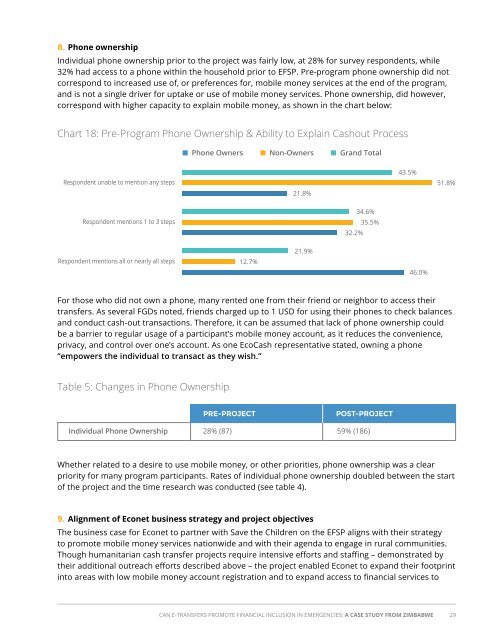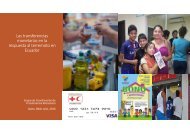Simatelele
2lF850q
2lF850q
Create successful ePaper yourself
Turn your PDF publications into a flip-book with our unique Google optimized e-Paper software.
8. Phone ownership<br />
Individual phone ownership prior to the project was fairly low, at 28% for survey respondents, while<br />
32% had access to a phone within the household prior to EFSP. Pre-program phone ownership did not<br />
correspond to increased use of, or preferences for, mobile money services at the end of the program,<br />
and is not a single driver for uptake or use of mobile money services. Phone ownership, did however,<br />
correspond with higher capacity to explain mobile money, as shown in the chart below:<br />
Chart 18: Pre-Program Phone Ownership & Ability to Explain Cashout Process<br />
■ Phone Owners ■ Non-Owners ■ Grand Total<br />
Respondent unable to mention any steps<br />
21.8%<br />
43.5%<br />
51.8%<br />
Respondent mentions 1 to 3 steps<br />
32.2%<br />
34.6%<br />
35.5%<br />
Respondent mentions all or nearly all steps<br />
12.7%<br />
21.9%<br />
46.0%<br />
For those who did not own a phone, many rented one from their friend or neighbor to access their<br />
transfers. As several FGDs noted, friends charged up to 1 USD for using their phones to check balances<br />
and conduct cash-out transactions. Therefore, it can be assumed that lack of phone ownership could<br />
be a barrier to regular usage of a participant’s mobile money account, as it reduces the convenience,<br />
privacy, and control over one’s account. As one EcoCash representative stated, owning a phone<br />
“empowers the individual to transact as they wish.”<br />
Table 5: Changes in Phone Ownership<br />
PRE-PROJECT<br />
POST-PROJECT<br />
Individual Phone Ownership 28% (87)<br />
59% (186)<br />
Whether related to a desire to use mobile money, or other priorities, phone ownership was a clear<br />
priority for many program participants. Rates of individual phone ownership doubled between the start<br />
of the project and the time research was conducted (see table 4).<br />
9. Alignment of Econet business strategy and project objectives<br />
The business case for Econet to partner with Save the Children on the EFSP aligns with their strategy<br />
to promote mobile money services nationwide and with their agenda to engage in rural communities.<br />
Though humanitarian cash transfer projects require intensive efforts and staffing – demonstrated by<br />
their additional outreach efforts described above – the project enabled Econet to expand their footprint<br />
into areas with low mobile money account registration and to expand access to financial services to<br />
CAN E-TRANSFERS PROMOTE FINANCIAL INCLUSION IN EMERGENCIES: A CASE STUDY FROM ZIMBABWE 29



